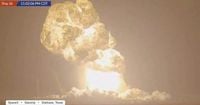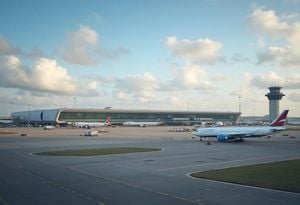Late Wednesday night, June 18, 2025, at SpaceX's Starbase facility in Texas, a dramatic explosion rocked the site, marking another setback for Elon Musk's ambitious space program. SpaceX's Starship 36, a towering 400-foot rocket, suffered a catastrophic failure during a routine pre-flight static fire test, resulting in a massive blast that illuminated the night sky with flames and sent plumes of thick smoke billowing over the surrounding area.
The incident occurred just after 11 p.m. Central Time, as the Starship 36 was undergoing the static fire test—a standard procedure where rocket engines are ignited while the vehicle is securely fastened to the launch mount. This test is a crucial step before any launch, designed to verify engine performance and safety without the rocket actually taking off.
According to a social media post from the Cameron County Constable Precinct 1, the explosion was sudden and severe, described as a "catastrophic failure" that destroyed the Starship. Fortunately, emergency protocols were swiftly enacted, and no injuries were reported. SpaceX confirmed in an early Thursday statement on X (formerly Twitter) that the safety perimeter around the test site had been maintained throughout the operation and that all personnel were accounted for and safe.
"Our Starbase team is actively working to safe the test site and the immediate surrounding area in conjunction with local officials," SpaceX stated, reassuring residents that there were no hazards to nearby communities and urging people to avoid approaching the area during ongoing safety operations.
Videos capturing the explosion quickly went viral on social media, showing the rocket’s nose suddenly bursting open, causing the screen to flash white briefly before dark smoke engulfed the sky. The blast was so intense that local residents reported their windows shaking and dishes rattling, underscoring the power of the explosion.
This incident marks the third consecutive failure for SpaceX's Starship program, which has faced a string of setbacks despite its groundbreaking ambitions. The Starship 36 was preparing for what would have been the tenth test flight of the massive vehicle, which stands approximately 123 meters tall. Previous tests have also ended in fiery explosions, including the ninth demo flight just weeks earlier, where the rocket experienced a "rapid unscheduled disassembly" shortly after liftoff.
During the latest test, it was reported that the first-stage Super Heavy booster exploded shortly after ignition, while the second-stage Starship may have suffered a significant fuel leak during flight, contributing to the catastrophic failure. These repeated setbacks highlight the immense challenges SpaceX faces in developing a fully reusable spacecraft capable of carrying humans and cargo to the Moon, Mars, and beyond.
SpaceX’s founder and CEO, Elon Musk, has publicly acknowledged the difficulties, noting that the company is learning from each failure and continuing to refine its technology. In the wake of the latest explosion, Musk’s focus appears to be shifting somewhat, as he recently admitted he had spent "a bit too much time on politics" and has reduced his involvement in government advisory roles to concentrate more on SpaceX and other ventures.
The Starship program remains one of the most ambitious aerospace projects ever undertaken, aiming to revolutionize space travel by providing a fully reusable rocket system. Despite the setbacks, SpaceX continues to push forward, testing and improving its designs at the Starbase facility in Texas.
Local authorities, including the City of Port Isabel, have been closely monitoring the situation and coordinating with SpaceX to ensure public safety. Firefighters responded promptly to the scene, and officials have maintained transparency with residents about the incident and ongoing safety measures.
While the explosion was a significant blow, it is not unexpected in the high-stakes world of rocket development, where trial and error are part of the path to success. Each test, even those ending in failure, provides valuable data that engineers use to enhance the design and reliability of the spacecraft.
SpaceX has urged patience and caution, emphasizing that the area remains off-limits while safety operations continue. The company and local officials are conducting a thorough investigation to determine the exact cause of the explosion, which will help inform future tests and modifications.
As SpaceX continues to innovate and push the boundaries of space exploration, the Starship 36 explosion serves as a stark reminder of the risks involved in pioneering new frontiers. Yet, it also underscores the company’s resilience and commitment to advancing humanity’s reach beyond Earth, even when faced with dramatic setbacks.
With the eyes of the world watching, SpaceX’s journey to perfect the Starship rocket continues, fueled by the determination to overcome obstacles and achieve what was once thought impossible.





